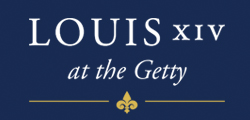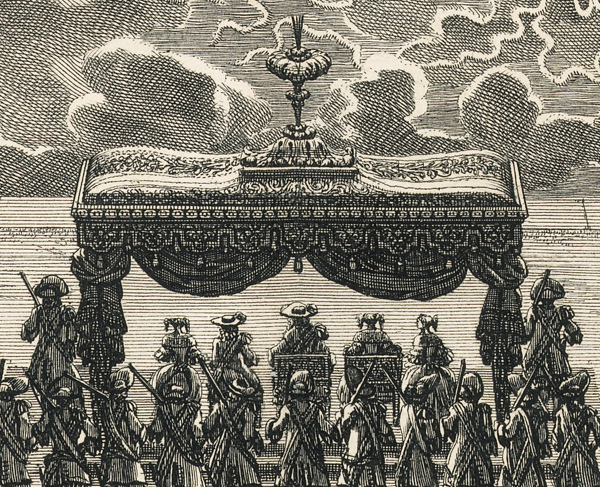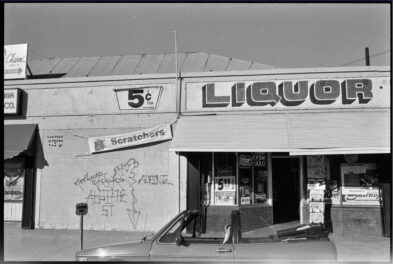Etchings and engravings in the Getty Research Institute’s current exhibition A Kingdom of Images: French Prints in the Age of Louis XIV picture the Sun King in a variety of roles: child king, powerful monarch, father, warrior, and dancer among them. Two works on display, however, show quite another side of Louis XIV—the back of his head! Here we see the king as a member of an audience, an honored spectator held in rapt attention by magnificent performances put on at the palace of Versailles in the 1660s and 1670s.

Second Day: The Performance of Molière’s Princess of Elide, 1673, Jean Lepautre after Israël Silvestre. Etching and engraving in Les plaisirs de l’Isle enchantée… (Paris, 1673 [1674]), pl. between pp. 20 and 21. The Getty Research Institute, 84-B21384

Louis XIV sits front row center at the performance of Molière’s play the Princess of Elide, flanked by his brother and sister-in-law at left, and his wife, Marie-Thérèse, Queen of France and Navarre, and his mother at right. More than a dozen figures appear upon the elaborate stage, with a long line of musicians occupying the orchestra pit below. This comedy-ballet, with music composed by Jean-Baptiste Lully, marked the second night of a weeklong celebration in May 1664 known as “The Pleasures of the Enchanted Island.”
While officially held in honor of Louis XIV’s mother and wife, the event unofficially honored his mistress, Louise de La Vallière. The multi-day fête drew its inspiration from Ludovico Ariosto’s sixteenth-century poem Orlando furioso, and Louis XIV himself participated in the festivities, playing the role of the hero Roger.

Fifth Day: Fireworks on the Grand Canal of Versailles, 1676, Jean Lepautre. Etching and engraving in André Félibien, Les divertissemens de Versailles donnez par le roy à toute sa cour au retour de la conqueste de la Franche-Comté en l’année M.DC.LXXIV (Paris, 1676), pl. between pp. 26 and 27. The Getty Research Institute, 84-B21393
The king occupies the same prime viewing position at an elaborate fireworks display ten years later. Under a canopy, again surrounded by members of the royal family, Louis’s body is on axis with a grand obelisk illuminated by the explosion of pyrotechnics. The sun atop it symbolizes the king and his power. This dramatic spectacle marked the fifth night of a festival held at Versailles over multiple days in July and August 1674 to celebrate Louis XIV’s conquest of the Franche-Comté (a province in eastern France).

Detail of fireworks in Fifth Day: Fireworks on the Grand Canal
Louis’s presence looms large in both works, even though his royal person occupies little of the compositions. He is evoked through the grandiosity and lavishness of these events: all of this is for him, because of him, thanks to him. Louis XIV certainly knew how to throw a party; his celebrations featured ballets, concerts, balls, parades, equestrian displays, and fireworks. They were also outrageously expensive, straining the resources of the French Crown.

Red morocco binding with the coat of arms of France. The following titles are bound together in this volume: Les plaisirs de l’Isle enchantée, Relation de la feste de Versailles, and Les divertissemens de Versailles. The Getty Research Institute, 84-B21384, 84-B21388, and 84-B21393
Engraved by Jean Lepautre, one of the most celebrated printmakers of the era, the Second Day: The Performance of Molière’s Princess of Elide and the Fifth Day: Fireworks on the Grand Canal of Versailles were included in publications recording the royal fêtes at Versailles in text and image. These festival books, Les plaisirs de l’Isle enchantée (1673); Les divertissemens de Versailles (1676); and Relation de la feste de Versailles (1679) were published by the Imprimerie royale (Royal Printing Press), and copies were given to foreign courts as diplomatic gifts. The publications sent an unmistakable message about the glory and power of this resplendent king: he was no mere spectator.
_______
A Kingdom of Images: French Prints in the Age of Louis XIV, 1660–1715 is on view at the Getty Research Institute through September 6, 2015. This exhibition was organized by the Getty Research Institute in special collaboration with the Bibliothèque nationale de France.




Comments on this post are now closed.
Trackbacks/Pingbacks